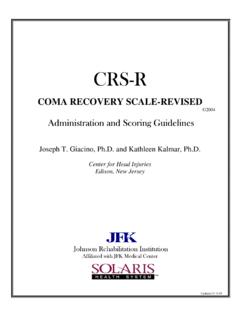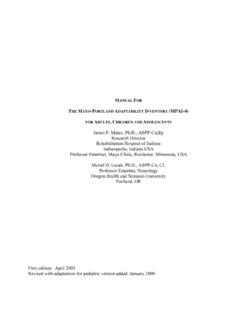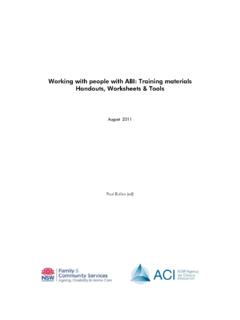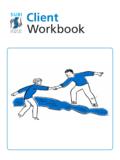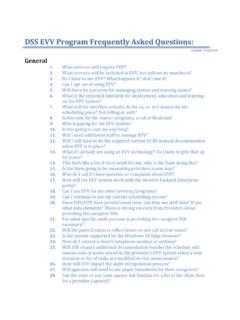Transcription of THE AYO-PORTLAND DAPTABILITY NVENTORY (MPAI-4)
1 MANUAL FOR. THE MAYO-PORTLAND ADAPTABILITY INVENTORY (MPAI-4). FOR ADULTS, CHILDREN AND ADOLESCENTS. James F. Malec, , ABPP-Cn,Rp Research Director Rehabilitation Hospital of Indiana Indianapolis, Indiana USA. Professor Emeritus, Mayo Clinic, Rochester, Minnesota, USA. Muriel D. Lezak, , ABPP-Cn, CL. Professor Emeritus, Neurology Oregon Health and Sciences University Portland, OR. First edition: April 2003. Revised with adaptations for pediatric version added: January 2008. ACKNOWLEDGMENTS. We are very grateful to our collaborators who have shared their time and their data in studies of the MPAI: Randall W. Evans, PhD, in memoriam. During his outstanding career, Dr. Evans was a leader in the field and worked with several pioneering programs for TBI rehabilitation. During his work on the MPAI, he was associated with the MENTOR ABI Network/National Mentor, Chapel Hill, NC. Karen L Finley, PhD, MENTOR ABI Network/National Mentor, Chapel Hill, NC. Ann Kent, Gentiva Rehab Without Walls, Melville, NY.
2 Dan Keating, PhD, and Suzanne Lentz, Bancroft Rehabilitation, Louisiana and New Jersey Jerry Villemain, Learning Services Corporation, Durham NC. And to colleagues who assisted in these efforts at Mayo: Miriam Kragness, PhD, Anne Moessner, RN, MSN, Jeffrey Thompson, MD, Lisa Degiorgio, MA, CRC, Angela L. H. Buffington, MA, CRC. We are grateful to those who reviewed a preliminary draft of this manual for their excellent feedback that was critical to the development this version: Glenn Curtiss, PhD, J. A. Haley Veterans Administration Hospital, Tampa, FL. Shannon Swick, Michigan Rehab Without Walls Karen A. Schwab, PhD, Defense and Veterans Brain Injury Center, Washington, DC. Keith Cicerone, PhD, JFK Johnson Rehabilitation Center, Edison, NJ. Cynthia Boyer, Bancroft Rehabilitation, Louisiana and New Jersey Kathryn Kendall, RN, BSN, Lisa Degiorgio, MA, CRC, and Susan Lepore, OTR, Mayo Clinic-Rochester, MN. We are thankful to Helen Badge and The Community Outcomes Project Working Group and New South Wales Brain Injury Rehabilitation Directorate Injury Rehabilitation staff for their assistance in developing a pediatric component to this manual.
3 The pediatric adaptation (MPAI-P) of the MPAI-4 is based on work by Bruce Oddson, PhD, at Laurentian University, Sudbury and his colleagues, Peter Rumney, MD, Patricia Johnson, PhD, and Nancy Thomas-Stonnell, BSc, DSP, at Bloorview Kids Rehab, Toronto, Ontario, This work was accomplished in part with support through a TBI Model System grant from the National Institute for Disability and Rehabilitation Research (NIDRR) in the Department of Education. TABLE OF CONTENTS. OVERVIEW 1. TEST MATERIALS AND USE. Test materials .. 2. User Qualifications .. 3. ADMINISTRATION AND SCORING. Completing the MPAI-4 . 4. Guidelines for completing individual items .. 4. Mobility 5. Use of hands 6. Vision .. 7. Audition .. 8. Dizziness .. 9. Motor speech 10. Verbal communication . 11. Nonverbal communication .. 12. Attention/concentration 13. Memory 14. Fund of information . 15. Novel problem-solving 16. Visuospatial abilities 17. Anxiety . 18. Depression 19. Irritability, anger, aggression.
4 20. Pain and headache 21. Fatigue .. 22. Sensitivity to mild symptoms .. 23. Inappropriate social interaction .. 24. Impaired self-awareness .. 25. Family/significant relationships .. 26. Initiation .. 27. Social contact .. 28. Leisure and recreational activities 29. Self-care .. 30. Residence . 31. Transportation .. 32. Paid employment .. 33. Other employment 34. Managing money and finances 35. Pre-existing and Associated Conditions .. 36. Alcohol use .. 37. Drug use .. 38. i Psychotic symptoms . 39. Law violations .. 40. Other conditions causing physical impairment 41. Other conditions causing cognitive impairment .. 42. SCORING, REFERENCE DATA, AND TEST INTERPRETATION. Scoring .. 43. Reference data 44. Test interpretation: Case examples 45. MPAI DEVELOPMENT AND PSYCHOMETRIC CHARACTERISTICS. Development . 48. Reliability .. 49. Validity .. 53. The MPAI Participation Index (M2PI) . 58. REFERENCES .. 63. APPENDICES. Raw score to T-score conversion tables 64.
5 Appendix I: National Sample Staff Ratings . 65. Appendix II: Mayo Sample Staff Ratings 68. Appendix III: Mayo Sample Ratings by People with ABI .. 71. Appendix IV: Mayo Sample SO Ratings . 75. ii OVERVIEW. The Mayo-Portland Adaptability Inventory (MPAI) was designed: to assist in the clinical evaluation of people during the postacute (posthospital) period following acquired brain injury (ABI), to assist in the evaluation of rehabilitation programs designed to serve these people, and to better understand the long-term outcomes of acquired brain injury (ABI). Evaluation and rating of each of the areas designated by MPAI-4 items assures that the most frequent and important sequelae of ABI are considered for rehabilitation planning or other clinical interventions. MPAI-4 items represent the range of physical, cognitive, emotional, behavioral, and social problems that people may encounter after ABI. MPAI-4 items also provide an assessment of major obstacles to community integration which may result directly from ABI as well as problems in the social and physical environment.
6 Periodic re-evaluation with MPAI-4 during postacute rehabilitation or other intervention provides documentation of progress and of the efficacy and appropriateness of the intervention. Research that examines the responses to the MPAI-4 by individuals with longstanding ABI and by their caregivers and close acquaintances helps to answer questions about the future of those who are newly injured, and their long-term medical, social and economic needs. Currently the MPAI is employed by a number of provider groups to evaluate the efficacy of the range of postacute rehabilitation interventions through pre- and post-intervention assessments of those served. Providers using the MPAI represent the full range of postacute services from community-based services through traditional outpatient rehabilitation and day programs to residential services. Now in its fourth revision, the MPAI-4 and its three subscales (Ability Index, Adjustment Index, Participation Index) offer measures with highly developed and well-documented psychometric properties.
7 These measures may be effectively employed in research applications as well as in clinical settings. The psychometric properties of the inventory are reviewed in detail (pp. 54-64). The brief 8-item Participation Index may serve as a particularly useful measure of the final common aim societal participation of rehabilitation or other intervention efforts. Throughout its development, the MPAI has been designed for possible completion by professional staff, people with ABI, and their significant others (SO). Research ( ) establishes the reliability of completion by these various rater groups and also documents characteristic biases of each. The MPAI-4. offers the possibility for combining results of the inventory completed by two or three rater groups to provide a potentially more reliable and representative assessment. MPAI-4 Items and Subscales The underlying subscale structure of the MPAI was explored extensively in analyses of data from previous versions of the MPAI.
8 These analyses led to the identification of three domains or subscales. Items were identified that correspond to rational grouping for three categories: Ability ( , sensory, 1. motor, and cognitive abilities); Adjustment ( , mood, interpersonal interactions); and Participation ( , social contacts, initiation, money management). Items by subscale or Index are listed in Table 1. Three items (Initiation, Social contact, Leisure/recreational activities) contribute to both the Adjustment Index and the Participation Index). The MPAI-4 provides the rehabilitation professional or other clinician with a brief and reliable means of assessing functioning in each of these three major domains to help target areas for intervention and assess progress. Table 1: MPAI-4 Items by subscales Ability Index Adjustment Index Participation Index Mobility Anxiety Initiation Use of Hands Depression Social contact Vision Irritability, anger, Leisure/recreational Audition aggression activities Motor Speech Pain and headache Self-care Communication Fatigue Residence Attention/Concentration Sensitivity to mild Transportation Memory symptoms Work/school Fund of Information Inappropriate social Money management Novel problem-solving interaction Visuospatial Abilities Impaired self-awareness Dizziness Family/significant relationships Initiation Social contact Leisure/recreational activities TEST MATERIALS AND USE.
9 Test Materials The MPAI-4 consists of this manual and the MPAI-4 form. The manual contains information on the development of the MPAI, detailed instructions for rating and scoring the items, interpretative guidelines, normative data, and information on the reliability and validity of the measure. The MPAI-4 form consists of four pages that contain brief instructions for completing the ratings for each item, the 29 items comprising the MPAI-4, 6 additional items (items 30-35) for recording additional preinjury and postinjury information about the person being evaluated, and the scoring area. The inventory has been translated into French, German, Danish, and Spanish. All materials for the MPAI-4, including the translations, are available for download on the web site ( ) for the Center for Outcome Measurement in Brain Injury (COMBI) sponsored by the National Institute of Disability and Rehabilitation Research (NIDRR) through its TBI Model System Program.
10 Drs. Malec and Lezak retain copyright to the MPAI-4 and previous versions. The MPAI-4 may be downloaded from the COMBI web site, copied, and used without fee or other charge. However, 2. distribution or sale of the MPAI-4, related materials developed by Drs. Malec and Lezak, and previous versions for profit, fee, barter, or trade is expressly forbidden. User Qualifications The MPAI-4 may be completed by people with ABI, their SO, medical or rehabilitation professionals, and other designated observers who know the individual well. People with very severe cognitive impairment should not be given the MPAI. Professional staff should review the rating guidelines provided in this manual prior to making ratings. People with ABI or their SO should have a professional who is experienced with the MPAI-4 review the rating guidelines with them prior to making ratings and be available to them to answer any questions that may arise during their completion of the inventory.


